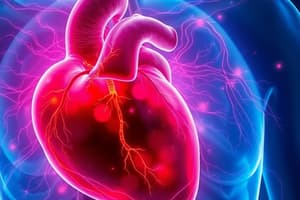Podcast
Questions and Answers
Which of the following best describes the fundamental issue in heart failure?
Which of the following best describes the fundamental issue in heart failure?
- The heart valves are too narrow, restricting blood flow.
- The heart's electrical signals are disrupted, causing irregular contractions.
- The heart muscle does not pump enough blood to meet the body's needs. (correct)
- There is a blockage in the coronary arteries preventing blood from entering the heart.
A patient's hBNP level returns as 150 pg/mL. Based on this lab value, which condition is most indicated?
A patient's hBNP level returns as 150 pg/mL. Based on this lab value, which condition is most indicated?
- Heart failure. (correct)
- Dehydration.
- Kidney failure.
- Normal cardiac function.
A patient with a history of hypertension is diagnosed with heart failure. How did hypertension contribute to the patient's heart failure?
A patient with a history of hypertension is diagnosed with heart failure. How did hypertension contribute to the patient's heart failure?
- Causing blood clots to form in the coronary arteries.
- Causing direct damage to the heart valves.
- Weakening or stiffening the heart muscle over time due to increased workload. (correct)
- Reducing the heart rate and cardiac output.
A patient is diagnosed with left-sided heart failure. Which of the following symptoms is MOST likely to be present?
A patient is diagnosed with left-sided heart failure. Which of the following symptoms is MOST likely to be present?
A patient with right-sided heart failure is exhibiting signs of systemic congestion. Which assessment finding would correlate with this condition?
A patient with right-sided heart failure is exhibiting signs of systemic congestion. Which assessment finding would correlate with this condition?
Which sequence accurately traces the flow of blood through the heart in relation to the lungs and the rest of the body?
Which sequence accurately traces the flow of blood through the heart in relation to the lungs and the rest of the body?
A patient with heart failure has developed ascites. Which side of the heart is MOST likely failing?
A patient with heart failure has developed ascites. Which side of the heart is MOST likely failing?
A patient presents with jugular vein distension, hepatomegaly, and peripheral edema. Which type of heart failure is the MOST likely cause of these findings?
A patient presents with jugular vein distension, hepatomegaly, and peripheral edema. Which type of heart failure is the MOST likely cause of these findings?
Flashcards
What is heart failure?
What is heart failure?
The heart muscle doesn't pump enough blood to meet the body's needs.
Heart failure pathophysiology?
Heart failure pathophysiology?
A heart defect or disorder damages/overworks the heart, decreasing cardiac output.
Heart failure S/S?
Heart failure S/S?
Signs and symptoms depend on whether it's left- or right-sided heart failure, related to blood flow.
Left-sided heart failure?
Left-sided heart failure?
Signup and view all the flashcards
S/S of left-sided HF?
S/S of left-sided HF?
Signup and view all the flashcards
Right-sided heart failure?
Right-sided heart failure?
Signup and view all the flashcards
S/S of right-sided HF?
S/S of right-sided HF?
Signup and view all the flashcards
What is hBNP?
What is hBNP?
Signup and view all the flashcards
Study Notes
- Heart failure happens when the heart muscle cannot pump enough blood to meet the body's needs.
Pathophysiology of Heart Failure
- Heart failure pathophysiology includes a congenital heart defect or disorder like coronary heart disease, cardiomyopathy, hypertension, or valvular disease damaging or overworking the heart.
- Damage or overworking of the heart results in decreased cardiac output.
Signs and Symptoms of Heart Failure
- Heart failure signs and symptoms differ, depending on whether it occurs on the left or right side of the heart.
- Blood flows into the right side of the heart, goes to the lungs, then to the left side of the heart, and then out to the rest of the body.
Left-Sided Heart Failure
- Left-sided heart failure occurs when blood backs up into the lungs, resulting in pulmonary congestion.
- Signs and symptoms of left-sided heart failure include dyspnea (shortness of breath), crackles (a crackling sound in the lungs), fatigue, and frothy sputum.
Right-Sided Heart Failure
- Right-sided heart failure happens when blood coming from the body backs up, causing systemic congestion.
- Signs and symptoms of right-sided heart failure include peripheral edema (swelling), ascites (fluid accumulation in the abdomen), jugular vein distension, and hepatomegaly (enlargement of the liver).
Labs and Diagnostic Tools for Heart Failure
- Diagnostic tools to diagnose heart failure are labs and screening procedures, such as echocardiograms and hemodynamic monitoring.
Labs for Diagnosing Heart Failure
- Labs to diagnose heart failure include measuring the patient’s hBNP level.
- hBNP is a hormone released by the heart in response to stretching.
- With heart failure, the heart does not pump effectively, causing a backup of blood, which stretches the heart and causes excess release of hBNP.
- hBNP level over 100 pg/mL indicates heart failure.
Studying That Suits You
Use AI to generate personalized quizzes and flashcards to suit your learning preferences.




